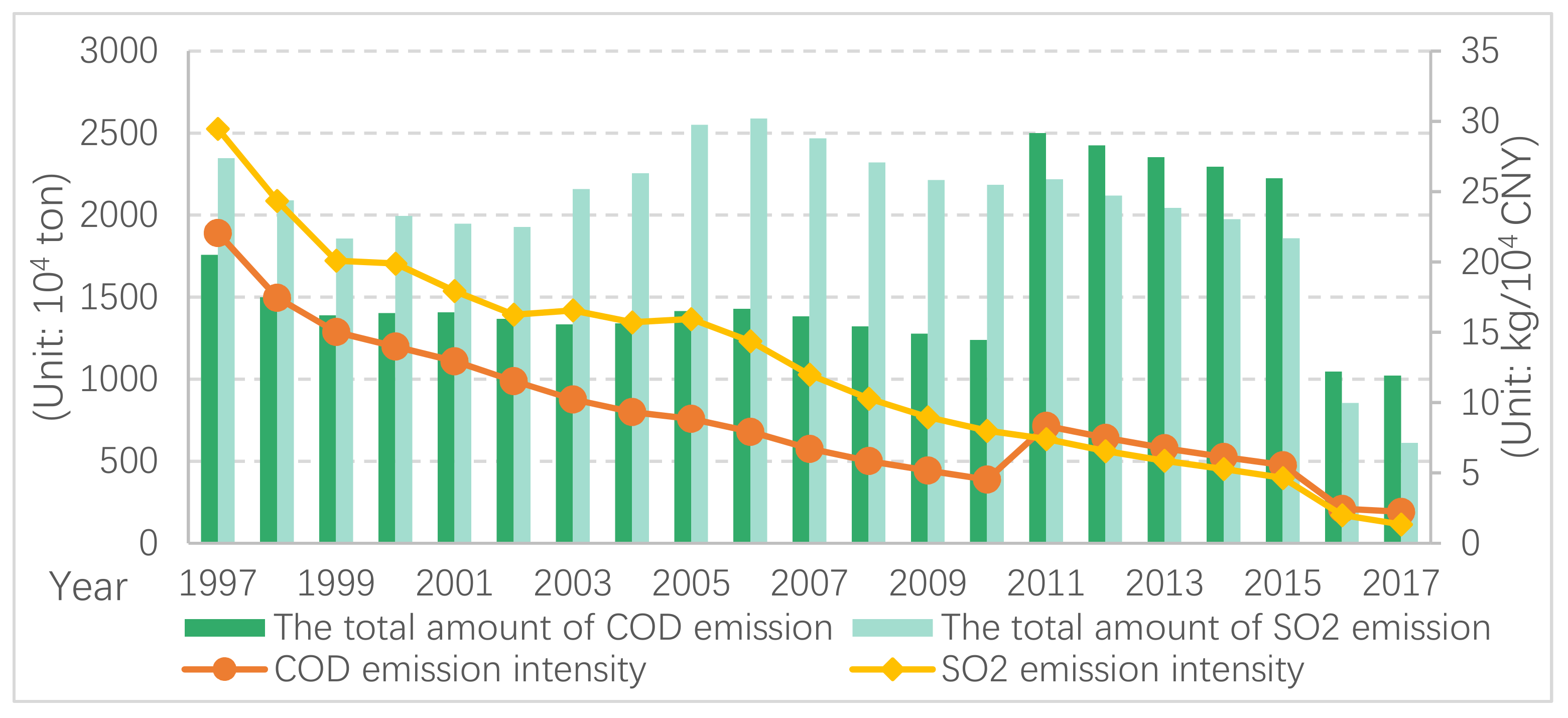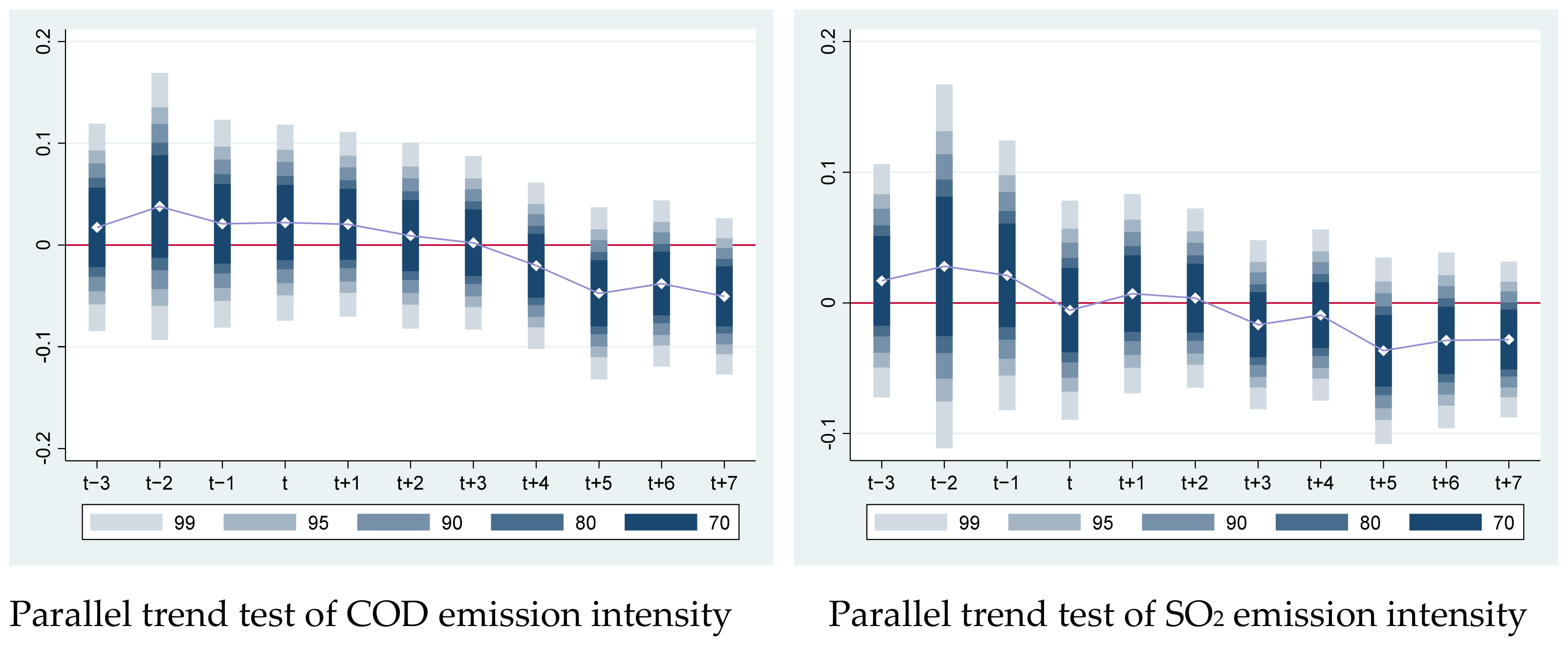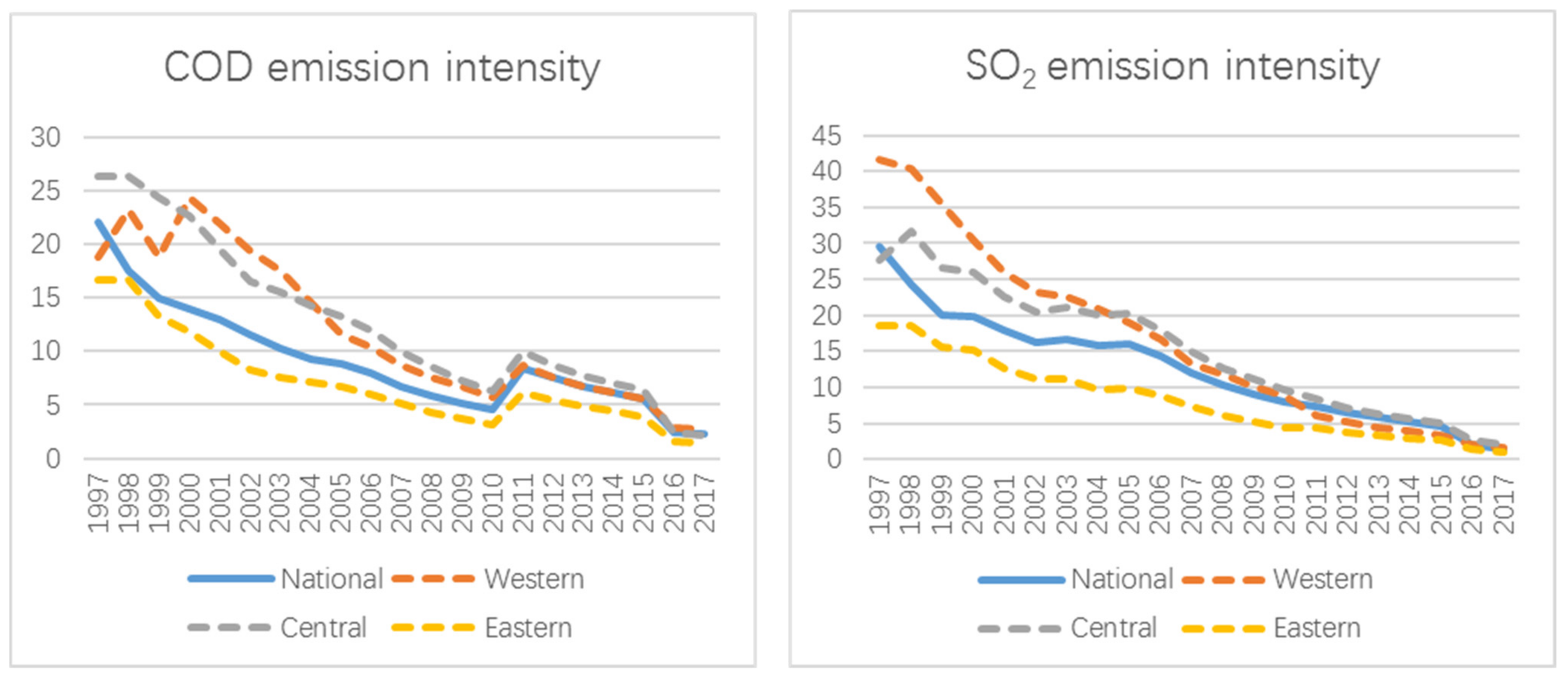1. Introduction
Economic development and environmental conservation are two key challenges for China, and they are also urgent problems worldwide. China has made a succession of gains in reducing poverty and combating climate change, while playing an important international role. In 2015, China’s per capita GDP was still lower than the world average, less than one fifth of the average of developed countries, and more than 70 million people still lived below the national poverty line. By 25 February 2021, China had announced the attainment of comprehensive poverty alleviation. With the rapid economic expansion, China is facing unprecedented environmental pressure. To overcome the contradiction of economic development and environmental conservation, the Chinese government needs to achieve maximum economic development at the lowest environmental cost.
China has actively pushed the strategic planning and execution of sustainable development. In 1995, the Ministry of Ecology and Environment (MEE) published the
Outline of National Ecological Demonstration Zone Construction Plan (1996–2050) [
1]. The outline of the plan required not only the strong development of social economy, but also the rational development and usage of resources and the active protection of the natural environment. The Ecological Demonstration Zone contains three dimensions: Eco-county, Eco-city, and Eco-province. The construction contents and associated indicators are formulated, respectively [
2]. Rather than focusing on a single ecological environment approach, the indicators take into account economic development, ecological environment protection, and social advancement. It adheres to the notion of locally independent and voluntary involvement and fully acknowledges the role of local governments. This province-level ecological civilization construction effort in China, which is unique from other local environmental regulations, piqued our interest in the potential effects of the program.
After being authorized as the first Eco-province (EP) pilot in 1999, Hainan province started looking into the creation of a provincial-level ecological pilot. Up until now, the state has successively launched 16 pilot EPs, including Hainan, Jilin, Heilongjiang, Fujian, Zhejiang, Shandong, Anhui, Jiangsu, Hebei, Liaoning, Guangxi, Tianjin, Sichuan, Shanxi, Henan, and Hubei. From the east, the middle, and then the west, the pilot EPs are gradually launched. Each province has released a construction planning blueprint for the EP, and according to that plan, the EP pilots will need 20 to 30 years to reach their objective by 2020 or 2030. Zhejiang province, which had been accepted as a pilot province in 2003, passed the pilot EP acceptance inspection in May 2020 and became China’s first EP.
EP is a regional policy implemented by each pilot province. The creation of EP policies and oversight of their execution fall under the purview of the province governments. In addition to legislation and official orders, policy also refers to the administrative tools employed to carry out policy objectives [
3]. Previous studies have shown that complex environmental governance typically encompasses several actors and regions, with overlapping authority structures in various system components [
4,
5,
6,
7]. The quality of an environmental policy is dependent on a number of variables, including its own design, aims, tools, processes, centralized authority, and implementation. Therefore, the impact of environmental policy implementation is frequently complicated and fraught with scientific uncertainty. Institutionally, people in charge of preserving the environment and those in charge of running the economy are kept apart. Governments face significant difficulty in creating policies that produce greater results for less money [
8].
There is disagreement in the current research on how environmental policy affects environmental quality. Some academics have unfavorable and critical opinions on the function and results of environmental regulation [
9,
10,
11]. The implementation of any public policy needs to rely on policy-implementation agencies and implementers, including government departments, enterprises, community groups, individuals, etc. According to Austrian Economics, entrepreneurship is what drives economic phenomena [
12,
13,
14]. However, state-interventionist policies could discourage innovative entrepreneurship and increase the cost of the industry. They urge the use of market-based environmental solutions. [
15,
16,
17]. Public choice theorists argue, neither the state nor the market is uniformly successful in enabling individuals to sustain long-term, productive use of natural resource systems. Public policy sometimes would result in a zero-sum game. And communities of individuals are an alternative solution of governing the commons [
18,
19,
20,
21]. Psychological effects are also related to public policy. Entrepreneurs are more willing to invest and innovate when they feel confident. High political and economic uncertainty of public policy will make companies lose the will to innovate [
22]. However, many academics stress that the government’s role is beneficial to long-term environmental protection and economic progress [
23,
24,
25,
26,
27].
Since the 1960s, with the increasingly prominent problems of resource scarcity and environmental pollution, the relationship between economic growth and environmental quality has attracted extensive attention of the governments and scholars [
23,
28,
29,
30,
31,
32,
33]. In the past two decades, the most representative study on the relationship between economic development and environmental pollution is the Environmental Kuznets Curve (EKC) [
34]. A large number of scholars found an inverted-U shape relationship between pollutant emissions and economic development in both short and long term [
35,
36,
37,
38,
39]. At the same time, through empirical studies, some scholars believed that the EKC hypothesis was difficult to be supported in the research area. [
40,
41,
42,
43]. Different research perspectives, data and econometric models may lead to different empirical conclusions on the EKC hypothesis. China has a very large land area, with great differences in regional economic and social development in the eastern, central, and western parts of the country. The variables ignored in the model can deviate the results making it difficult to obtain reliable conclusions. Therefore, in reflecting the relationship between economic development and environmental pollution, the EKC method maybe not the most appropriate to analyze the situation in China.
Several publications from the previous two decades have discussed the evaluation criteria and methodology for EP [
44,
45,
46]. Some researchers have identified the policy effect from the dimension of a single province, such as Hainan [
47], Heilongjiang [
48], Zhejiang [
49], and Fujian [
50]. Some scholars analyze the policy effect of EP from the standpoint of the entire nation. Studies already conducted have identified geographical variations in EP construction and shown that eastern China has a higher level of ecological construction than central and western regions [
51]. Comprehensive EP legislation can support ecological innovation and foster economic growth [
52]. The policy has significantly reduced carbon emissions [
53], and has showed the increase in ecological footprint per capita [
54]. Furthermore, academics offer suggestions for improvement, believing that there are still some issues with the policy implementation process [
55].
The emission intensity of COD and SO
2 thus far has received far too little consideration. Pollutant emission intensity index is defined as pollutant emission per unit of GDP. This indicator, which is comparable across regions and time periods, directly shows the environmental cost paid for its economic growth. Due to the lower intensity of pollutant emissions, the region’s economic growth causes less environmental harm, which is more consistent with the objective of sustainable development [
56]. Pollutant emission intensity is explicitly included as one of the nine binding metrics in the EP building indicators. The COD emission intensity should be less than 5.0 kg/10
4 Chinese Yuan (CNY), and the SO
2 emission intensity should be less than 6.0 kg/10
4 CNY, per the index requirements. This study’s specific goal was to examine how province environmental policies in China affected the relationship between regional environment and economic development, regional heterogeneity, and the mechanism of such influence by introducing COD and SO
2 emission intensity as the starting point.
Figure 1 shows the trend changes in China’s overall pollution emissions and emission intensities. As demonstrated, China’s overall COD emissions decreased between 1997 and 2017. The significant increase in 2011 is mainly because of the change of the statistical caliber of total COD discharge. The overall SO
2 emission fluctuates greatly correlated with economic growth. From 1997 to 2017, the emission intensities of COD and SO
2 exhibited a consistent lower trend, showing a drop in the environmental input per unit of economic output and a significant increase in China’s overall environmental efficiency.
Figure 2 displays the distribution of pollutant emission intensities in pilot and non-pilot provinces in the years 2000, 2005, 2010, and 2015. Both in pilot EPs and non-pilot provinces, it demonstrates the declining trend in emission intensities. Pollutant emission intensity varies greatly between provinces, however. Particularly between 2000 and 2005, there was a large discrepancy between the provinces, however between 2010 and 2015, this difference significantly decreased. Pollutant emission levels across provinces show a trend toward convergence, however the rate of convergence varies [
57].
(1) Is it possible for the EP pilot area to lower pollutant emission intensities more successfully than non-pilot provinces? (2) Does the policy impact on pollutant emission intensities vary by region? (3) What is the mechanism by which policy is implemented? This study offers fresh empirical proof of the structure of Chinese environmental governance. In the conflict between economic development and environmental protection, it can also serve as a model for other emerging nations.
The sections of this document are grouped using the following structure: The study techniques and data are mostly introduced in
Section 2. The empirical findings are reported and discussed in
Section 3. The research conclusion and policy suggestions are presented in
Section 4.
4. Conclusions
China’s overall pollution emissions and pollution intensity decreased steadily from 1997 to 2017. In comparison to the non-pilot provinces, the pilot provinces’ COD and SO2 emission intensity has decreased dramatically since the EP policy’s adoption. After the EP policy is put into place, it aids China in easing the burden of economic growth on the environment. The impact of policies varies by region, though. It matters in the western and central pilot provinces since they initially have relatively high pollutant emission intensities. However, the policy effect is not significant in reducing pollutant emission intensities in the east pilot provinces whose pollutant emission intensities are lower than the national average.
By analyzing the mechanism of policy action, we find that the EP policy considerably reduces pollutant emission intensities mainly through increasing GDP per capita and invention, which is the main mediating pathway of policy action. At the same time, the policy also raised the pollutant emission intensity in the pilot provinces by increasing the proportion of industrial industries and reducing the investment in environmental protection by industrial enterprises. The collection of pollution discharge fees in the pilot provinces resulted in an increase in SO2 emission intensity but no discernible impact on COD emission intensity. In the pilot provinces, local financial investments in environmental protection had no significant effect on the index.
Based on the above findings, we put forward several policy suggestions: First, different construction targets should be set for different regions. More challenging goals and more market-oriented means should be utilized to boost the incentive to reduce emissions in economically developed locations with high pollution emissions. Second, local finances in the pilot provinces should be more inclined to invest in environmental protection. Enhance the long-term viability of local government environmental protection programs by improving their sustainable operation. Third, the pilot provinces should promote innovation in investment and financing mechanisms for the environmental protection industry. By increasing government investment in environmental protection and government procurement, improve the environmental protection industry venture capital mechanism to attract more social capital to enter the environmental protection industry and broaden the sources of funding and cooperation models for environmental protection investment.
There are still some missing mediating variables in SO2 emission intensity. In order to thoroughly understand the mechanism of the policy, more studies will be required in the future that will add more mediating variables to the model. Whether the implementation of EP can support other aspects of social and economic growth also requires further research.











